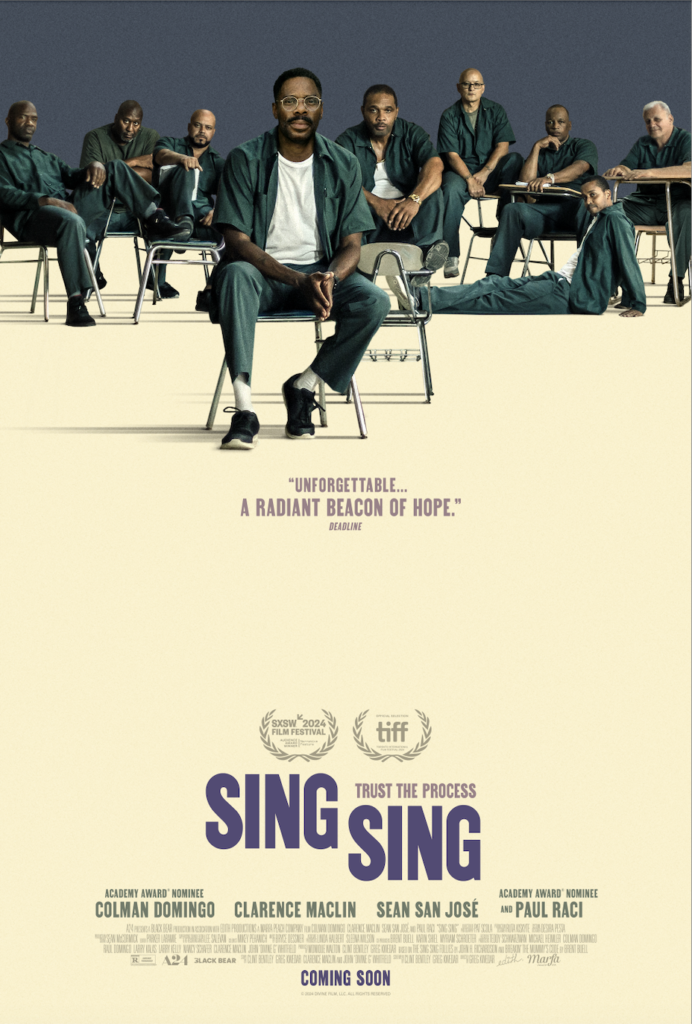By Kharisma McIlwaine
Art proves that it can change lives, regardless of circumstances.
Recently, A24 hosted a private screening of the film “Sing Sing.” Based on a true story, “Sing Sing” tells the first-hand story of “Divine G,” played by Tony and Emmy award-winning and Oscar-nominated actor Colman Domingo. Domingo’s character is based on the life story of his co-star Clarence “Divine Eye” Maclin.
In the film, Divine G is incarcerated in Sing Sing, one of America’s most notorious prisons, for a crime he didn’t commit. Despite the hopelessness of his current situation, Divine G finds new purpose by participating in a theater company he co-founded, where he plays the role of playwright and actor alongside other men in prison. When an unexpected member joins the group, the men perform their first original comedy, combining elements of Shakespeare, Egyptian history, “Nightmare on Elm Street,” and more. The film takes audiences on an emotional journey as it highlights the power of art while focusing on the humanity of those incarcerated – a concept often dismissed in our punitive justice system.
Ultimately, Sing Sing is a story about redemption and the possibilities that lie beyond creativity when people are seen as more than the sum of their mistakes. The film offers audiences an authentic look into this story of perseverance, told from the perspective of the men who lived it. The story arc reveals the complex web of human experiences behind bars, allowing audiences to see the search for freedom denied, dreams never realized, the pain of loss, and the glimmers of joy found in brotherhood and friendship.

Colman Domingo and Clarence “Divine Eye” Maclin in a scene from “Sing Sing”.
Photo courtesy: A24
Sing Sing is both heartbreaking and heartwarming, but also a necessary tool to help remove the stigma so often attached to our incarcerated people. Not only does the film highlight the transformative power of art, but it also features an unforgettable ensemble of formerly incarcerated actors who are given the opportunity to tell different aspects of their own stories on film.
What sets Sing Sing apart is not only its compelling storyline, but also its close connection to the real-life Rehabilitation Through the Arts (RTA) program. Founded in 1996 at the Sing Sing Correctional Facility, RTA has been a shining example and beacon of hope to thousands of inmates through arts-based workshops that have proven to be life-changing. The film is a powerful example of the impact of RTA.
Since its inception, RTA has grown from a single theater workshop to a comprehensive arts program operating in several New York State prisons. The success of the program is truly remarkable. Statistics have shown that less than 3% of RTA members return to prison, a stark contrast to the national recidivism rate of 60%, proving once again that the power of art prevails.
Beyond the statistics, Sing Sing captures the essence of personal growth and community building fostered by RTA and similar programs. The program has not only transformed individual lives, but has also contributed to a positive change in prison culture, recognized by both participants and facility staff. Hundreds of RTA alumni have pursued higher education and given back to their communities as social workers, lawyers, academics and entrepreneurs, demonstrating the program’s success in breaking the cycle of incarceration.
Programs like RTA have been shown time and time again to literally transform the lives and development of participants in arts-based rehabilitation programs.
Immediately following the screening of “Sing Sing,” there was a panel discussion about the importance of programs like RTA. The panel was moderated by Suave Gonzalez, Pulitzer Prize-winning artist and former incarcerated podcaster, Jane Golden, executive director of Mural Arts of Philadelphia, and Dawn Michelle Chamberlain, former incarcerated speaker and author of “Cell to CEO: Stop Playing and Get Your Sh** Together.” Panelists shared personal anecdotes about how programs like RTA have profoundly impacted their lives.
“It was a miracle that we were able to get this program off the ground,” said Golden, who started one of Philadelphia’s first restorative justice programs. “We built such a close bond with Suave and the men in the class that continues to this day.”
“At first, I think you were all very skeptical,” Golden said. “You said, ‘White people come, put this on their resume, raise money and then leave,’ and I believe that. But we’re a very tenacious group at Mural Arts and we do our work with a lot of integrity, and it would have been shameful if that had happened. So we were very dedicated and totally inspired. We did that little mural and in some ways never looked back. It was life-changing to be there. I want to be very clear — we didn’t just teach. It was 100% mutual how we were influenced.”
Chamberlain shared her thoughts on the film as well as her personal experiences with how art can be used as a path to healing.
“The film was very real and very similar to my experience and the triggers. The story couldn’t have been told better than it was,” she said. “My incarceration was in the West Virginia federal system. I spent 2 years, 2 months, 2 weeks and 2 days in custody. During our incarceration, we started an arts rehabilitation program that I was able to continue. We are now in our eighth year at Chester Community Charter School, working there on arts rehabilitation for trauma treatment,” Chamberlain said. “We realized that while we were in the criminal justice system, there were people who were not doing well. Nothing was getting through to them. Our regular therapeutic efforts, the drug programs, just weren’t working. What struck me in my first few weeks was that we were engaging in arts and arts programs, that it was a language that everyone understood. There was a sense of euphoria and vulnerability that came across in everyone… just a beautiful experience. So I said, ‘You know what? We need to do this more often.'”
Gonzalez, who spent 31 years in Graterford State Prison and was one of the founding members of the Mural Arts Program in Pennsylvania prisons, expressed gratitude for how transformative the program has been in his life and the lives of the men in the film.
“People ask, do these prison programs work? I would say yes,” he said. “When we started Mural Arts, we basically wanted to create something for ourselves so that when we came home, we would have something to fall back on. We learned a whole new set of skills. As we saw here today, five of the actors here (in the film) were in Sing Sing (the prison) – I met all five of them. To see someone from Sing Sing go on to be a person who probably wins a whole bunch of awards – it’s incredible! They’ll probably play other roles in other films. That’s what these programs do.”
Sing Sing is more than just a film; it is a testament to the enduring human spirit and the power of artistic expression. The film shows the real-world impact of programs like RTA. The film also challenges viewers to rethink their ideas about incarceration and rehabilitation. Sing Sing is an opportunity to appreciate the transformative potential of art and the importance of programs that give hope and meaning to those behind bars. It is a powerful tribute to the resilience of the human spirit and the life-changing impact of creative expression, even in the most difficult circumstances.
“Sing Sing” is currently playing in select cinemas nationwide. Check your local listings for showtimes.




